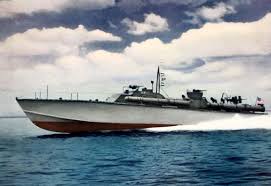 The following is a recollection of Alvin W. Parry. Parry, a long-time resident of Brevard County, Florida, served on the US Navy’s Motor Torpedo Boat ‘Liberty Hound’ (PT-194), Squadron Twelve, in the South Pacific during World War II. The history books don’t include stories like this about the rise and fall of Five-Star General Douglas MacArthur.
The following is a recollection of Alvin W. Parry. Parry, a long-time resident of Brevard County, Florida, served on the US Navy’s Motor Torpedo Boat ‘Liberty Hound’ (PT-194), Squadron Twelve, in the South Pacific during World War II. The history books don’t include stories like this about the rise and fall of Five-Star General Douglas MacArthur.
~ ~ ~ ~ ~ ~ ~ ~ ~ ~ ~ ~ ~ ~ ~ ~ ~ ~ ~ ~ ~ ~ ~ ~ ~ ~ ~ ~ ~ ~
It was a typical New Guinea day—bright sunshine, hot tropic breezes and PT boats maneuvering about the vast harbor of Dreger, just across the island of New Britain in the Southwest Pacific.
Most boats waited their turn to refuel, others needed replenishment of ammo or some form of help from the base force technicians. It was routine to begin boat clean up early, as soon as we returned from the previous night’s patrol.
After the boat was in ready condition the crew could hope for a couple of hours rest and maybe a game of red-dog or five-card stud. Occasionally there was a meal, or what sufficed, sometimes hard to identify unless we were fortunate enough to be eating with the Seabees.
Every so often we would spot a large ship in the area, generally quite a distance away but close enough to chance a run to “check our engines!” When possible we would choose a cruiser. They always carried good chow! And since a man-o-war couldn’t stop in combat waters, we would do a fast run around her then maneuver alongside the zigzagging goody wagon and do our thing. This meant a call from the skipper for all the “heavy-weights” to stand on the bow.
The PT boat crews seldom wore more than their skivvies (good old Navy boxers) or cut-off dungarees. We created quite a sight for the spit and polish cruiser sailors. We looked like prisoners of war, mostly six footers and under 150 pounds!
With a skillful hand at the wheel there was about five minutes to look up at the the cruiser deck and in unison beg for food! Invariably, the skipper of the cruiser would look down at us and then we would hear the ship’s PA system bark a most rewarding order, “feed those guys!” The food would drop and never, but never was the smallest ration lost, including an occasional pie dropped from 30 feet.
This story is about one of those trips to a cruiser, but has nothing to do with begging for food. The ship was the light cruiser Nashville that was underway, yet awaiting at sea the arrival of the Pacific’s Supreme Commander, the illustrious and awesome five-star General Douglas MacArthur.
PT-194, the Liberty Hound, was quietly sitting at one of the Dreger Harbor jetties, most of the crew doing their particular thing to ready the boat for the night’s patrol. We were suddenly aware of the skipper on the run and apparently rather excited. He jumped aboard and called us together for a briefing.
Quickly we learned that the Supreme Commander was ashore for a visit of some sort and that the ’94 boat had been ordered to cleanup and standby to return the General to his flagship. Responding to this order was no small task; the ’94 was ready but how about the crew? Most had no idea where to find a clean set of dungarees, much less a white hat!
There were a couple of guys, Gunner Steve Martin and gunner Reme Bouchard, who were unsure that they even owned such gear. With the help of some of the “fatherly types,” (at least 23 years old) chief Torpedoman Frank Kelley and Torpedoman Tex Shirley, we ended up looking presentable but nothing to brag about.
I hasten to add that the Supreme Command represented a real deity to most of the younger generation. Occasionally, he could be spotted flying overhead in his command aircraft with six or eight fighter escorts. On the ground it was simple to figure out who rated such attention.
It was not uncommon to spot hot and sweaty GIs genuflecting to the heavens and uttering some very non-religious verse that didn’t come from their spiritual training.
Of course, the PT boaters were a little more respectful as our Lt. John D. Bulkeley had brought the General and his family out of Corregidor on the PT-41. The General, from that day on was known to hitch many PT boat rides, including a ride to the beach on his return to the Philippines.
In the early afternoon, the commotion we expected began to happen. A small well-armed convoy of jeeps suddenly pulled up to the jetty and there he was, the man-god we had heard so much about: corncob pipe, slouched hat encrusted with gold braid, baggy pants and, as I remember, a “swagger stick.” He was the news-maker of our time.
Surely, Go d wouldn’t carry a swagger stick but this one did and he carried it with defined authority.
d wouldn’t carry a swagger stick but this one did and he carried it with defined authority.
He bade good-bye to whomever he had visited and with a distraught looking colonel, jumped aboard the PT-194 in a very agile manner. Needless to say, we had all been given our orders. Our skipper undoubtedly would rather have been on the front lines with the Marines and the rest of us were too spellbound to appreciate the gravity. Without mishap we pushed off with those three powerful Packard aircraft engines whirring under the care of a real pro, motormachinist John Ansteatt.
The skipper got underway then immediately turned to our very capable executive officer, Lt. James W. Costello, and asked him to step into the cockpit to take the wheel. Then with a short salute to the General’s aide, disappeared.
I noticed the General wandering about the deck chatting with crew members, stopping be each man’s general quarters station. Far from any expectation that I would ever be addressed by a Supreme Being, it happened. I don’t believe that the worst night of combat could compare with, “how are you son, where are you from?”
I replied, “Fine sir, I’m from Virginia.” He smiled and replied, “my favorite state,” then moved on.
It didn’t take too long to reach the Nashville. She was moving on a zig-zag course at the slowest allowable speed. From about three miles we could view most of her crew on deck, all at attention, ready and waiting to pipe aboard the supreme commander.
To set the scene correctly, there was a set of stairs over the side of the Nashville. They dropped to about three or four feet above the waterline with a platform at the bottom and a cable hand-line.
The ’94 began its approach for a touch landing whereupon it was expected that the Supreme would make a jump from the bow of the boat to the platform of the Nashville’s stair ladder. We all realized that Lt. Costello was an ace for such landing, but he was faced with a rough sea plus the wash created by the moving Nashville.
Aboard the PT-194, we were a crew of naval reservists; the only regular Navy man was Chief Quartermaster Oliver E. Davis, a former crew member of the U.S.S. Tennessee. Naturally, he was expected to be our mentor and know everything Navy, and without a doubt, have the best sea-legs aboard.
I must add that what we expected to do was extremely dangerous, even for the most experienced. But who were we to deny the Supreme? He was well aware of how the transfer was to be made and I had a sneaking feeling that he was looking forward to it–must have had something to do with proving one’s self!
Chief Davis was instructed to go forward with the Supreme and assist him in the transfer once a suitable touch was made. The time would be about two seconds for the entire act. As we all knew, PT boats had nothing to hold on to; it was a matter of sturdy sea-legs.
The ’94 was bobbing in the high waves and we all held our breath with eyes riveted on the General. Only the pulsating throb of the Nashville’s engines made a sound over the lapping waves. Everyone knew that one misstep would send the General for a meeting with Davy Jones!
Chief Davis was forward at the very edge of the starboard deck. The Supreme angled his gold-laden cap, drew his swagger stick under his arm and went forward. To even a surprised Lt. Costello a perfect touch was made and quickly Chief Davis assisted the Supreme over to the water drenched platform.
We were all staring. After all, how many times does one get to watch God jump? Can you believe–the Deity’s feet hit the platform, slid out from under him and only by the grace of the real Most High was he able to grab the cable hand-line and sit down hard on the wet platform. At that precise moment, our Chief Davis broke out in a loud horse laugh with god looking up and passing on a wind-blown remark. He quickly stood and ascended the ladder with a moon-size round of wetness on his bottom. With the Nashville crew at full attention, hopefully their eyes did not catch the Supreme’s wet posterior, which could well have been the most embarrassing moment of his historical life!
No, there was not a court-marital awaiting Chief Davis. But we` were all anxious to know why he dared to laugh. Why the horse laugh? Davis claimed the laugh was uncontrollable, as were his immediate afterthoughts of being shot by a firing squad and then burned and hanged for his sacrilegious act. Today, I’m sure we could find a textbook explanation, perhaps stress related syndrome.
A recent letter from Chief Davis, now retired USN Commander, reveals: “Yes, the General did jump to the deck of the gangway ladder which was wet and yes he did get the seat of his pants wet. He lost his hat or swagger stick, I can’t remember which. I laughed when he said he wasn’t hurt because he could have been.” Incidentally, Chief Davis is now a retired Municipal Judge of Anadarko, Oklahoma.
Who are a bunch of naval reservists to question the only US Navy regular aboard. He was there and he did the laughing. If Saint Peter talks to heroes and listens to sea stories, bet the Supreme has told him this one!
 Vice Admiral John D. Bulkeley, USN with Alvin W. Parry at PT Boater’s Annual Reunion.
Vice Admiral John D. Bulkeley, USN with Alvin W. Parry at PT Boater’s Annual Reunion.
References:
Lt. Bulkeley
USS Nashville